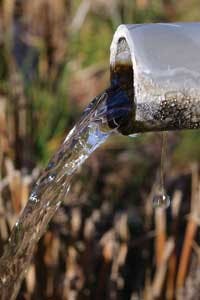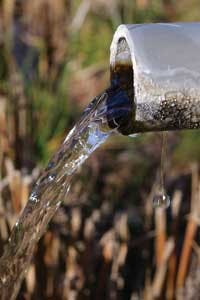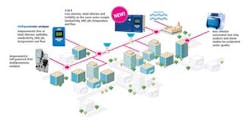By Stela Diamant
New developments in water quality monitoring and analysis are now providing utilities with the technologies to operate fully integrated "smart" water supply systems. But how should systems plan an optimal network of smart analyzers that can provide all the data and precision that they need?
Even though manual water sample testing is still standard practice in many locations for monitoring water quality and chemical balance, municipal water distribution networks are gradually and surely moving toward automated and smart monitoring systems that are more reliable, precise and maintainable. It can hardly be avoided. In some places the city water supply is drawn from different water sources, which results in varying water quality levels that must be carefully monitored. Treatment systems must respond to more stringent standards and requirements for water quality processes, and to the need for vigilant monitoring to protect against natural and industrial incidents and security threats that can contaminate the water anywhere along the route of a city's distribution system.
The Smart Water Networks Forum (SWAN) has outlined the five levels of a smart water network: the physical layer; sensing and control; data collection and communication; data management and display; data fusion and analysis. Much focus is now being placed on the last layer as the ultimate component to classify a system as smart, but utilities must invest in technologies that can carry out the functions of the three middle levels in order to deliver all the necessary data for final analysis and system improvement. Advanced online water monitors and analyzers that are now available on the market incorporate the necessary functions to provide a full picture of the water's quality at all times, to relay the information and display data for processing and response.
An effective smart water distribution system must invest in multiple installations of accurate online analyzers at strategic points in the network, so as to ensure optimal water delivery management. Alarm systems along the route enable management to respond immediately so that a chemical imbalance and possible contamination can be detected, isolated, examined and treated as it occurs. Ultimately, this sort of enhanced system serves to reassure inhabitants that, even in the case of a reported water hazard, the water reaching their taps will be clear, clean and safe.
Optimal Water Analysis Points and Parameters
A municipal system can achieve high-accuracy monitoring and cost-effective practice by employing a system of analyzers and controllers that enable multiparametric analysis (as opposed to analyzers that monitor only individual parameters) at key points in the treatment process. A smart system of devices will identify, quantify and analyze a range of parameters such as total chlorine, free chlorine, turbidity, pH, conductivity, ORP, temperature and flow, and will communicate real-time reports and alerts online for optimal communication and effective management at all times. It is most advantageous to install smart analyzers based on diverging stages of distribution in the network.
As such, the first optimal site for a multiparameter analyzer is at the point of exit from the purification plant. Here various parameters must be monitored, with an emphasis on turbidity and chlorine levels. At this initial stage, water drawn from the source has just undergone filtration, chlorination and other processes that remove contaminants and introduce purifying chemicals. Monitoring the turbidity and chlorine levels simultaneously as the water leaves the purification plant will give the best possible indication of whether the filtration and disinfection process has been successful and has achieved the necessary standards as the water flows towards the municipal distribution system.
A recently launched device developed by Blue I Water Technologies (called the TurbiPlus) achieves this by actually testing chlorine and turbidity on the same water sample. On the one hand, chlorine measurements - one of the most critical measurements in the municipal water treatment system - will indicate whether the correct level of chlorine is present to provide sufficient disinfection power. However, even if the chlorine levels are shown to be correct, turbidity (indicating residual suspended matter, such as mud, silt, clay or sediment) that might remain in the water despite the filtration process can shield contaminants and interfere with disinfection and balance that the chlorine is intended to achieve. This, of course, poses a health concern and requires intervention.
Should turbidity be higher than permitted at this point, it likely indicates that the filtration process in the purification plant requires maintenance or that the source water is more highly polluted and turbid than the plant could handle. An imbalance in the chlorine levels will indicate the need to adjust dosing at the purification plant.
Once the water has entered the municipal distribution network, it should be tested before branching out into neighborhood water mains. At these points the water should ideally be tested for free or total chlorine, turbidity, conductivity, ORP, pH, temperature and flow, each of these parameters allowing management to detect and treat pumping, disinfection and infrastructure anomalies as they occur. Other effective points that should be considered for water analysis are upon leaving storage reservoirs, water towers and any other form of water storage in the network.
Analyzers located immediately before entering residential complexes will provide a final checkpoint for drinking water quality and enable municipalities to assure residents that the water entering their homes is safe for consumption. Here, durable low-energy, self-powered analyzers can be installed so that accurate measurements can be taken without relying on electricity connections, monitoring free chlorine, ORP, pH, temperature, flow and pressure.
Lastly but no less important, residents or maintenance companies can install chlorine detection analyzers for rooftop water tanks that store municipal water and that constitute one more stop before entering consumers' homes. A tank can develop mold or contaminating bacteria from foreign organisms that can find their way in. Regional laws or recommendations might require that water tanks be emptied, inspected and cleaned once every two or three years, or once a year in the best case - but it takes only one day for water to become contaminated or for its chlorine levels to become unbalanced and unfit for home use.
An Eye on Accuracy, Costs and Reliability
Whether for a large-scale city water utility or a small community water distribution system, a wise distribution of high-precision colorimetric and amperometric water analyzers will serve as a reliable gatekeeper to ensure consumers can rely on quality drinking water from the network. Revolutionary electro-optic sensor technologies can provide accurate measurements and online reporting. Monitoring individual parameters will indicate specific problems but not all, and it is important to understand that one parameter will influence another. Therefore, installing versatile devices enables users to measure various parameters at once to give the full picture of a system's water quality, resulting in reduced costs, reduced maintenance and fewer on-site visits.
Installing multiple units at key locations provides utilities with the full range of data required to run a valuable smart system. It ensures consistency and reliability that builds community trust in the water system, as well as environmental and personal safety.
About the Author: Stela Diamant is Chief Technical Officer at Blue I Water Technologies, a global provider of water quality analyzers and controllers. Prior to joining Blue I, she served as director of advanced process control solutions for MKS Instruments, Inc. Diamant holds patents in plasma sources, optical components process, and automated process control. She is a graduate of the Technion-Israel Institute of Technology with a PhD in Physical Chemistry. She can be contacted at [email protected].





